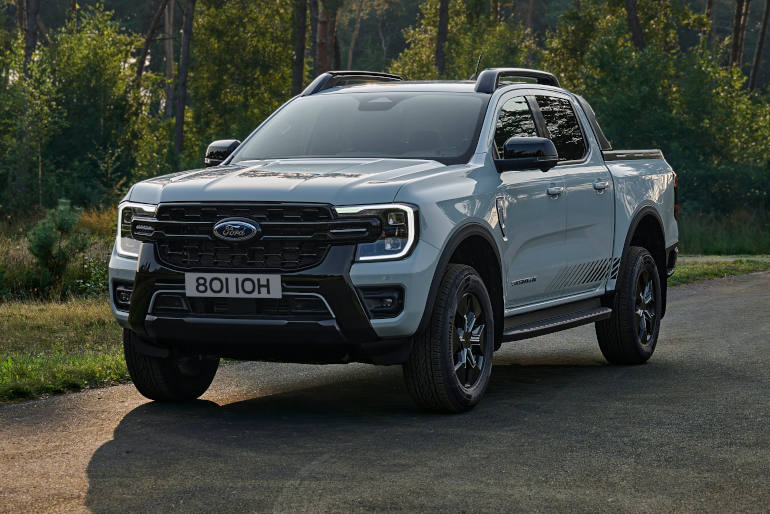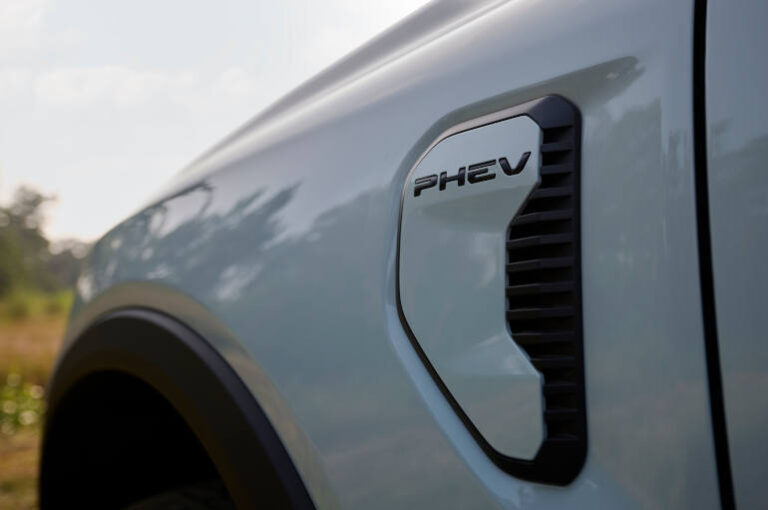Ford has unveiled the highly anticipated Ford Ranger PHEV to a global audience at IAA Transportation in Hanover Germany. It is confirmation that fleet managers will be able to continue purchasing their favourite ute and reduce CO2 emissions without compromising payload or towing.
The Ford Ranger PHEV combines a powerful and efficient 2.3-litre turbocharged four-cylinder EcoBoost petrol engine with a 75kW electric motor (e-motor) and 11.8kWh (usable) battery that can be charged from an external power source, by the petrol engine when driving in EV Charge mode and via regenerative braking when driving, making use of power that would otherwise be lost.
Coupled with Ford’s 10-speed automatic transmission, Advanced 4WD system with electronically controlled two-speed transfer case (offering 2H, 4A, 4H and 4L), Selectable Drive Modes and a rear differential lock, the hybrid powertrain can carry a family of four in comfort, tow up to 3500kg, provide exportable power via Pro Power Onboard2, and deliver more than 45 kilometres of electric-only driving range.
“The Ranger PHEV delivers all the versatility and capability people expect from a Ranger,” said Rob Sharples, chief engineer, Ranger Plug-in Hybrid, Ford Motor Company. “It can tackle tough terrain, tow a trailer with ease, be driven in town as an EV or, thanks to Pro Power Onboard be used as a mobile power plant when you’re off grid.”
Capability delivered
Ranger PHEV’s parallel hybrid architecture enables the full combined power and torque of both the petrol engine and e-motor to be deployed simultaneously for enhanced performance on- and off-road.
“Not all hybrid vehicles are the same, and our mission was to ensure the Ford Ranger was as versatile and capable as possible,” said Sharples. “Our engineering teams worked very hard on keeping Ranger’s core off-road capability while adding in the performance and efficiency of a hybrid powertrain.”
Key to ensuring Ranger PHEV wouldn’t compromise on the truck’s legendary capability was the integration of Ford’s modular hybrid transmission (MHT) into the driveline, sitting neatly between the petrol engine and 10-speed automatic transmission.
The MHT consists of an e-motor and separator clutch nestled between the engine and transmission (forward of the torque converter), adding just 160 millimetres to the transmission’s overall length. Not a bolt-on component, the MHT is built on the same line as the 10-speed automatic transmission and is a completely integrated component.
The separator clutch allows torque from the internal combustion engine (ICE) to blend with torque from the e-motor for full hybrid performance and efficiency, or it can decouple the two propulsion systems and allow Ranger PHEV to be driven as a regular ICE vehicle or as an EV.
By keeping the 10-speed automatic transmission, Ranger PHEV maintains the truck’s excellent towing, load carrying and all-round performance capabilities. The e-motor housed in the MHT provides additional torque, an extra hit of power and regenerative braking to help improve fuel efficiency as well as supporting Pro Power Onboard2 when generator mode is active. The system offers up to a maximum of 6.9kW with a cabin socket output of 2.3kW and two outlets in the load bed with an individual outlet limit of 3.45kW.
“The MHT is the key ingredient in ensuring Ranger PHEV delivers the capability we know our owners expect from a truck with a Ranger badge, along with enhanced versatility, impressive low-end torque and an overall faster responding powertrain which means improved performance compared to regular Ranger,” said Sharples.
“In high-demand situations, like overtaking, the combined power and torque of the petrol engine and e-motor can be sent to all four wheels,” said Sharples.
Intelligent driving
The Ranger PHEV powertrain offers the range and performance of a modern petrol engine alongside the efficiency of an electric vehicle thanks to an 11.8kWh (usable) battery. The traction battery sits neatly between specially engineered frame rails.
The e-Motor allows Ranger PHEV to deliver electric driving capability, and drivers can choose when and how they deploy battery power using either Auto EV, EV Now, EV Later or EV Charge modes.
Auto EV: keeps Ranger PHEV in the best mode for performance and efficiency.
EV Now: provides all-electric drive.
EV Later: keeps a portion of the battery charge in reserve so that it can be deployed later.
EV Charge: recharges the battery while driving.
When the battery reaches its lowest state-of-charge, the powertrain automatically reverts to Auto EV mode – supplementing petrol engine power with electric motor assistance using recaptured energy for optimised fuel-efficiency.
In addition to its EV modes, Ranger PHEV’s Terrain Management System uses selectable drive modes to enable customers to tailor their drive experience to road, weather and terrain conditions on demand. Available modes include Normal, Eco, Sport, Slippery, Tow/Haul, Mud/Ruts and Sand – with each drive mode featuring a unique graphical display in the 8.0-inch instrument cluster as well as fine-tuning throttle, transmission and traction control response for enhanced performance. A low-range transfer case and rear locking differential ensures excellent off-road capability.
Sport mode has been borrowed from Ranger Raptor and helps customers get the most out of the Ranger PHEV’s 2.3-litre EcoBoost engine. This mode enhances throttle response while the 10-speed automatic transmission holds lower gears longer for improved take-off performance.
“Whether you’re driving around town, exploring the world beyond the bitumen or working or camping off-grid, Ranger PHEV delivers the capability we know our owners expect, along with the added efficiency of a hybrid powertrain, and the versatility offered by Pro Power Onboard2,” concluded Sharples.







